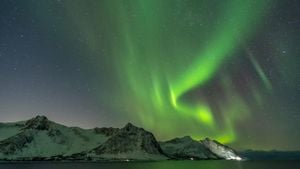The Northern Lights, or aurora borealis, have recently captured the world's attention, especially with thrilling sightings reported from various corners of the globe. These stunning light displays, characterized by vibrant green and red hues swirling across the sky, are often viewed as one of nature's most mesmerizing spectacles.
On August 14, 2024, residents of Erin Prairie, Wisconsin, witnessed the auroras dancing overhead alongside the radiant Perseid meteor shower. This remarkable celestial coincidence was captured beautifully on timelapse, showcasing the geomagnetic storms lighting up the Wisconsin sky.
Such geomagnetic storms occur when charged particles from solar winds collide with the Earth’s magnetic field. The energy released during these interactions results in the enchanting colors and movements of the northern lights, drawing onlookers to the cold, clear nights to marvel at Mother Nature's artistry.
Not only did the skies of Wisconsin shine brightly, but similar stunning displays were reported across Europe and North America. Reports of the aurora borealis emerged from regions including Cornwall and Devon in the UK, where townsfolk experienced the breathtaking spectacle over their urban surroundings.
Residents were quick to capture the moment, sharing photos and videos on social media, which sparked excitement among stargazers from all walks of life. The northern lights had not been visible for weeks prior, making these recent sightings even more special.
A timelapse video recorded from the International Space Station highlighted the ethereal beauty of the northern lights as well. Astronaut Matthew Dominick shared his perspective from above, where the moon set against streams of red and green aurora illuminated the horizon, evoking envy among those on the ground.
Space experts have noted the increase in ideal conditions for the aurora borealis due to recent solar activity. Persisting solar storms have propelled charged particles toward Earth, leading to enhanced visibility of the phenomena away from the traditional polar regions.
For many experiencing the aurora, witnessing the stunning interplay of color and light can feel almost otherworldly. Across the UK, the lights flooded the skies, with notable reports of people simply pausing their busy lives to enjoy the rare chance to see this natural wonder.
Specialists advise would-be spectators to head to areas with minimal light pollution for the best chance of viewing the lights. This tactic improves visibility and allows for clearer, unhindered views of the auroras as they dance overhead with grace and elegance.
The phenomenon isn’t just visually captivating; it's steeped in cultural significance. Many indigenous cultures have long revered the auroras, weaving stories and folklore around them, emphasizing their powerful connections with the earth and the cosmos.
Astronomy enthusiasts often gather during geomagnetic storms with fellow stargazers, armed with cameras and snacks, eager to chase down the next glimpse of these radiant lights. Observing the northern lights can become more than just viewing; it transforms from merely visual delight to communal experience shared with friends and family.
Interestingly, scientists continue to research the northern lights to understand better the magnetosphere's impact on our climate and technology. These studies are increasingly important as our world becomes more reliant on satellite technology, which can be affected by solar activity.
With each display of the aurora borealis, people from all walks of life share their awe and wonder. The strong current of excitement during these moments reminds us how powerful and beautiful nature can be.
For many, the northern lights are more than just lights; they symbolize hope and inspiration. Those who stood together under the brilliant illumination found themselves humbled by nature's artistry, igniting passion for exploration and appreciation for the celestial.
Experts remind the public how the phenomena of the aurora borealis is interconnected with larger cosmic cycles primarily initiated by solar flares. Each magnetic storm can lead to variations, transforming color schemes and visibility even for casual observers.
For those hunting the northern lights, planning around the lunar calendar can also be beneficial due to the impact moonlight has on visibility. Darker nights during certain lunar phases can amplify the stunning colors of the display, granting sky watchers spectacular memories.
While predicting the exact timing for auroral displays remains complex, scientists often release real-time updates during peak solar activity periods. This sharing of information allows eager observers to strategize their viewings, enhancing their chances of encountering one of nature’s most extraordinary light shows.
Climatic conditions play equally significant roles during auroral events, impacting not merely visibility but the sheer potential for wonder. Wind patterns and local weather conditions can affect how auroras manifest, spurring joy and disappointment across different regions.
For individuals across Europe and North America, the recent aurora sightings serve as reminders of nature's unfathomable beauty. Such displays uplift spirits and ignite curiosity about the universe and our place within it, leading to increased interest and enthusiasm for both amateur astronomy and scientific study alike.
The next few weeks are expected to hold additional opportunities for northern lights viewing as we approach peak solar activity. Enthusiasts encouragingly reach out to those desperate to witness this phenomenon firsthand, creating communities around these breathtaking shared experiences.
For those planning to catch the upcoming displays, experts recommend checking forecasts regularly to pinpoint regions where the auroras might appear. Preparedness often makes the difference between witnessing the awe-inspiring lights or simply dreaming about them.
With every aurora sighting, stories are shared, memories created, and friendships forged. Whether wrapped up warmly outside on crisp, clear nights or glued to timelapse videos streaming from space, the northern lights will continue to inspire and entrust their watchers with moments of raw, unfiltered beauty.
Indeed, it’s not simply about seeing and taking pictures; it’s about feeling connected to something larger. The aurora borealis acts as nature's reminder of the vastness of the universe, sparking intrigue and invoking wanderlust around the globe.



